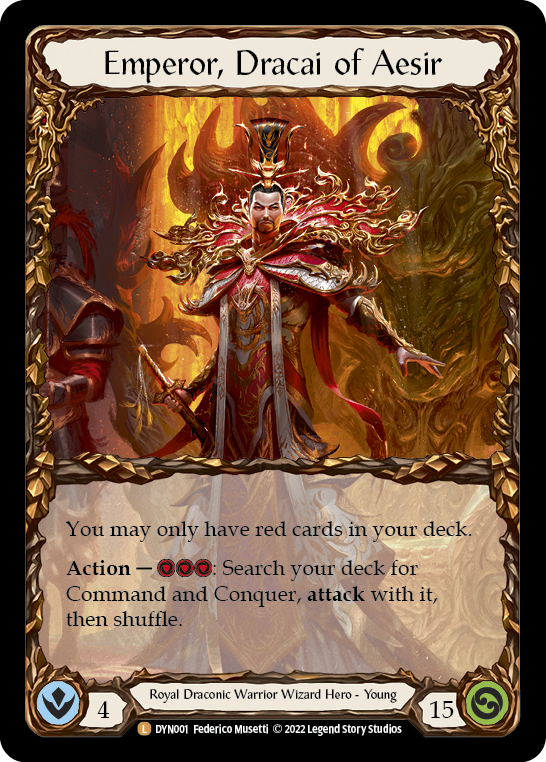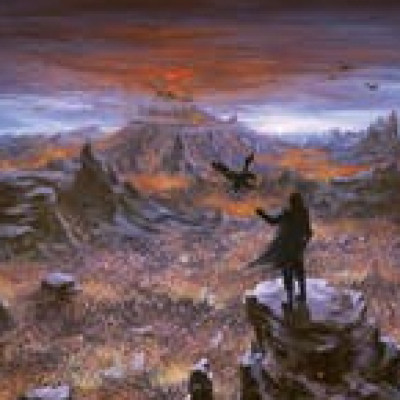Expansion set releases are an exciting time for Flesh and Blood. As opposed to standalone sets- which feature new heroes and deep card pools designed for straightforward deckbuilding and interwoven synergy- expansion sets aim to give everyone a little something fresh, to improve fringe strategies or invent entirely new ones. Standalone sets give you new decks; expansion sets shake up the ones you already have.

We're now sitting 2 weeks after Dynasty's release, and if you're anything like me, you've only begun to scratch the surface of the dense deckbuilding left in its wake. Perhaps you're feeling overwhelmed by options, or you're trying to make good decisions on singles purchases you'll actually use.
Today, I'm going to lay out the terms and guidelines I use when revisiting and rebuilding decks. There's no right or wrong way to go about it, but I find that having a strategy, an overall plan of attack, helps.
1. Open as much as you can, as soon as you can
I remember being a kid collecting TCGs. The slow trickle of new boosters corresponding with my limited allowance-based income. The excitement of opening a booster where every card was new to me; the value I'd place in a single high-rarity card, and how I'd work to craft a deck around it simply because I had it. It seemed a new set's novelty never wore off.
Sometimes, I miss those days. What used to be a couple boosters a week is now a couple cases on release day- but there's little to be gained from manufacturing that experience and pacing yourself. The sooner you know what you have to work with, the more efficient and effective you can be with your deck building.
If your budget can sustain it, buy all that you're going to buy- and open it all- on release day.
If your budget can sustain it, buy all that you're going to buy- and open it all- on release day. That way, any work you do on your decks is relevant. That doesn't mean you have to stop buying; I'm a big proponent of giving business to your local game store, and buying a few packs every week is a great way to thank them for letting you take up space in their shop. But do the bulk of your booster busting before you start working your decks over.
2. Identify the cards that you're excited about
The first month of a new set's release is a free-for-all in a churning and unrefined meta. You want to take full advantage of that to try wild things and make mistakes without the usual guarantee of defeat at the hands of your local gatekeepers.
(Yes, there may be sharks in the waters that prey on the janky deckbuilding that comes with new releases, running their tried-and-true builds for easy wins, but ignore those humbugs for the moment!)
As you look over your new cards, what jumps out at you? Which cards are you pumped to have in hand? What new idea simply speaks to you? Seize that inspiration and run with it- that spark is the best fuel you could find for your starting point.

For me, that was Emperor. Legendaries are always exciting, but there was a little something extra about the deckbuilding challenge he posed that enraptured me- and because he could only use red cards, my parameters were also narrowed in a way that made the deckbuilding process a little less complicated. Balancing a pitch curve was out the window, and I could focus on finding cards and playlines that suited him. He was also a brand new deck for me, which meant I didn't have the baggage of a tested, reliable build and well-loved cards getting in the way of fresh ideas.
3. Build towards your next event
"Okay, but I'm excited about lots of new cards! How do I narrow that down?"
Boy, do I feel you there. Going into this set, I was keyed up to add Arakni to my 'mains', explore Azalea's Sandscour prospects, forge the Nitro Mechanoid, and revitalize Boltyn with Spirit of Eirina. (I did, in fact, pull none of those cards - but I digress!)
Deckbuilding is an enjoyable pastime in and of itself, but for most of us, the real joy comes once you're shuffled up and put it into action. In the interest of getting playtime as soon as possible, I recommend building a deck for your next game night. The locals will appreciate your bringing something new and gleaning experience from you, and you'll get feedback on your work while the options are still fresh in your mind.
Be community minded, and take a few weeks off from being too competitive.
Remember those sharks I mentioned above? Here's where you can do your part to keep the 'new expansion love' alive. Be community minded, and take a few weeks off from being too competitive. Test new things. Help your local players get reps in against a variety of new decks, cards, and strategies. Don't (solely) do your testing on Talishar or Tabletop Simulator; bring physical cards to in-person games and share in the fun of figuring it all out together.
If you know your local scene has been wearing out its patience for Oldhim, don't revitalize your Guardian deck first. If you've got a player in your group who doesn't have a deep collection and probably won't have something new to bring yet, don't come in with the 'new and improved' version of their go-to. Switch it up and help to make a new release feel like a new experience for everyone involved.
4. New, updated, or replaced?
Once I've got my first build done and I'm ready to take a more expansive, comprehensive approach to integrating a new set, I like to take stock of my decks (I maintain 27 of them) and sort them into three categories:
- Minor updates:
Some card swaps, but core strategy remains. - Major updates:
The core strategy has been greatly enhanced, requiring many card swaps- but it is, at its heart, still the same deck. - Complete rebuild:
There is a new core strategy I'd like to pursue, and there's no point in trying to retain anything of the old.
(You could add a 4th to this approach for brand new decks - Arakni, for example, is drawing from nothing - but as we're talking specifically about the deckbuilding challenges that come with an expansion set, I'm going to stick with the 3 in the box for now.)
I literally list these out on a whiteboard in my game room, with color coding and format-based columns; but you can simply list them out on a note in your phone or a piece of paper. Anywhere you can refer to it going forward, because you're going to use this to guide your work. Knowing how big the job is can help you choose well for the time - and brain cells - you have available to give to your deckbuilding.
Major Updates are the hardest deck builds to do, so save these for those days when you can bring your A-game to the workshop.
I honestly feel that the Major Updates are the hardest deck builds to do, so save these for those days when you can bring your A-game to the workshop. Updates require that you keep in mind what was working before, while integrating what you hope will be an improvement on what wasn't working so well. There's a whole lot of 'kill your darlings' - a phrase used in writing circles to encourage you to set aside your personal fondness for a story element for the sake of the overall narrative - that goes on in a massive deck update.
This is where card assessment tools can become incredibly handy. Knowing where a card is deriving its value from helps you decide which card fits your deck, and which require support you can't provide to net their payoffs. Gemini wrote a piece on card roles back in 2021, and more recently World Champion Michael Hamilton offered his insights into how he places value on a card in a Pro Series piece for our subscribers.
I highly recommend keeping your old decklists online, even as you make improvements on them. This way, you can always backtrack to earlier iterations when your new brew doesn't go as planned. A site like FABDB is ideal for this purpose.
5. Don't be in a rush to update everything
Once you've got a few decks rebuilt, you can take a breath and take stock of your situation. Are there essential cards missing before you should bother updating that deck? Is there a strategy you're not quite sure of, and you'd like to see how it develops? Maybe you'd like to keep a few tried and true decks just as they were, at least for now, so you've got some you know you can win with.
It's okay to take a beat; it's okay to have decks in process. You can keep those notes on hand and get around to the rest when inspiration strikes, when trades get made and singles get bought, or simply when you have more time.
Deck building can be an incredibly fun and rewarding part of the hobby - so don't let unnecessary pressure drive you to get it all done with as quickly as possible! Pace yourself, work at your own speed, and enjoy it.




